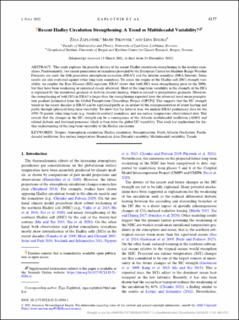Recent Hadley circulation strengthening: a trend or multidecadal variability?
Journal article, Peer reviewed
Published version

Åpne
Permanent lenke
https://hdl.handle.net/11250/2998254Utgivelsesdato
2022Metadata
Vis full innførselSamlinger
- Geophysical Institute [1198]
- Registrations from Cristin [9791]
Sammendrag
This study explores the possible drivers of the recent Hadley circulation strengthening in the modern reanalyses. Predominantly, two recent generations of reanalyses provided by the European Centre for Medium-Range Weather Forecasts are used: the fifth-generation atmospheric reanalysis (ERA5) and the interim reanalysis (ERA-Interim). Some results are also evaluated against other long-term reanalyses. To assess the origins of the Hadley cell (HC) strength variability we employ the Kuo-Eliassen (KE) equation. ERA5 shows that both HCs were strengthening prior to 2000s, but they have been weakening or remained steady afterwards. Most of the long-term variability in the strength of the HCs is explained by the meridional gradient of diabatic (latent) heating, which is related to precipitation gradients. However, the strengthening of both HCs in ERA5 is larger than the strengthening expected from the observed zonal-mean precipitation gradient (via Global Precipitation Climatology Project, GPCP). This suggests that the HC strength trends in the recent decades in ERA5 can be explained partly as an artifact of the misrepresentation of latent heating and partly through (physical) long-term variability. To show that the latter is true, we analyze ERA5 preliminary data for the 1950-1978 period, other long-term (e.g. 20th century) reanalyses, and sea surface temperature observational data. This reveals that the changes in the HC strength can be a consequence of the Atlantic multidecadal oscillation (AMO) and related diabatic and frictional processes, which in turn drive the global HC variability. This work has implications for further understanding of the long-term variability of the Hadley circulation.